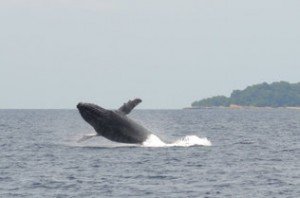
(Charlotte Observer) Anne Gordon de Barrigon, 53, has lived in Panama for 7 1/2 years; she operates Whale Watching Panama ( www.whale watching panama.com ), which offers whale- and dolphin-watching trips. The Seattle-area native trained animals for movies and TV. She fell in love with Panama while on a shoot in the jungle, and decided to stay there.
Q: When is whale-watching season there?
Panama is one of the few places where you get humpback whales from Alaska as well as Antarctica. July-October is the best season; we get several thousand from Antarctica; December-February, there are several hundred from Alaska. In season, you can see whales as close as where all the ships line up to enter the Panama Canal. The ideal place is the Pearl Islands, in the Pacific. They’re a 90-minute ferry ride from Panama City, or a 15-minute flight.
Q: When whales come, is it gradual? Or is it a “holy cow” kind of thing?
They come to breed and give birth. Heavily pregnant females arrive first, in mid- to late-June, then the other females and males come up. Last season and this season in the Pearl Islands, all of our trips had sightings.
There are several thousand of them along the entire Pacific coast of Panama, but there are times when you see them in almost every direction.
Q: How close do you get?
We start out at a respectful distance, maybe several hundred yards. We generally go out in a catamaran sailboat, which is quiet. We turn off the motor and drift. If the whales are traveling, we’ll stay at least 100 yards away. Yesterday we were drifting and there were whales off to the side. They turned around and came back to us. One surfaced near us and dove under the boat. A mother and young baby were in front of us, just under the water. They came within inches of the boat.
The whales know exactly where we are. There’s never been an incident of a humpback jumping on a boat. We’re entering their world and they may have babies with them. We want to appreciate and honor them, not hassle them.
Q: How big are they?
Females are larger, and can get up to 50 feet long and weigh up to 50 tons. To put it in perspective, our boat is 44 feet long.
Q: Do they make noises?
Humpbacks are among the most vocal whales. The males sing a song but you usually don’t hear it unless you’re right near them. But if you’re underwater, you can hear the sound up to 20 miles away. You can be in water at the beach, out of sight of them, and hear it loud and clear.
Q: What’s it sound like?
It’s very eerie. It can go high and low. It’s kind of like a radio between frequencies, only different.
Q. Are these repeat visitors you can recognize?
They’re generally repeat whales. We take photographs if we can of the underside of the tail when the whale is diving – each has a unique pattern; it’s like a fingerprint. I share the photos with scientists, who can try to match ours with theirs.
So far, there are so many whales that it’s hard to know them individually. Humpbacks aren’t like an orca pod that always travels in the same families. Orcas in Washington state are extensively studied and documented. These whales here aren’t.
The whales are kind of Panama’s best-kept secret. Tourists and locals often have no idea we have them here because they’re not looking – they’re driving cars and doing their jobs. The whales don’t come near Panama City, but you don’t have to go out too far in a boat to see them.
Q: What do these whale-watching trips cost?
A day-tour at the island can start at $125 and includes the boat, lunch, drinks and the guide. We do a lot of those for people who are on a tight tour schedule. We also have people coming specifically for five-day trips.